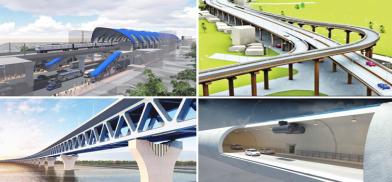Megaprojects of Bangladesh: Competitive opportunities for its development partners
Unlike many other South Asian countries, Bangladesh's prudent and selective engagement with China's BRI has helped Dhaka avoid debt problems, writes Sheikh Abdur Rahman for South Asia Monitor

Standing in its 50-year landmark, Bangladesh is witnessing rapid economic development. It has shown its capacity by tackling the economic shocks amid the Covid-19 pandemic, maintaining a positive economic growth, accelerating trade and investment partnerships and ensuring developmental transition through initiating megaprojects and finding various avenues of investment opportunities.
Megaprojects are large-scale and billion-dollar complex ventures that involve multiple public and private stakeholders. They have a far-reaching impact on millions. For a developing country like Bangladesh, infrastructure megaprojects are the critical catalyst for accelerating economic growth. In the ongoing budget for 2021-22, Bangladesh has allocated $5.45 billion (BDT 47,283 crore) from the total annual development programme to implement 12 megaprojects to strengthen the country's communication, power and energy sector.
The fast-track project consists of nine Moheshkhali floating LNG terminals, Padma Bridge, Dhaka Metro Rail, Padma bridge rail link, Rooppur nuclear power plant, Matarbari power plant, Payra deep seaport, Dohazari-Cox's Bazar-Gundam rail line and the Maitree Super Thermal Power Plant. The LNG terminal has been completed and the long-cherished Padma Bridge is expected to be inaugurated on June 23.
The government has proposed the highest allocation of approximately $2.12 billion (BDT 18,426 crore) for the country's first nuclear power plant, the Rooppur Nuclear Power Plant in Pabna, which Russia has implemented.
Megaprojects
The second highest allocation is for the Matarbari Coal-based Power Plant at $710 million (BDT 6,162 crores). Other mega projects are being speedily implemented. These fast-track projects are expected to change the landscape of the increasing need for communication and power infrastructural demand.
The Padma Bridge is fully funded by Bangladesh. For all of the remaining projects, the country relies mainly on loan grants and aid from development partners -- China, Japan, Russia and India. As a small country and on the highway to developmental transition, Bangladesh wants to maintain good contacts with all the parties.
However, the warning by China over joining the QUAD and the US sanctions on RAB and seven other former and present officials shows that the country is facing the dilemma of taking sides. To stay neutral and continue the development transition, Bangladesh will have to be more cautious.
Among the ongoing fast-track nine megaprojects, three have been funded by China, Japan is funding the Dhaka Metro Rail and Matarbari deep seaport; Russia and India are financing one project each.
China's role
Since 2015, China has been the top trading and investing partner for Bangladesh. The country has implemented several energy and transportation projects, including the flagship megaprojects of Padma Bridge Rail Link and the Payra Coal-fired power plant. The issue of debt management of multi-dollar projects has often been raised.
Exemplified with Pakistan's Gwadar port and Sri Lanka's Hambantota, some economists express concern over whether Bangladesh is falling under the "debt trap" by joining the Belt and Road Initiative (BRI).
However, unlike many other South Asian countries, Bangladesh's selective engagement with China's BRI has helped Dhaka avoid debt problems. For instance, the country called off the Chinese-funded Sonadia deep sea port project due to its economic vulnerability from being close to the other deep-sea port at Matarbari.
On the other hand India, the closest neighbour of Bangladesh, has been unable to match China's big-ticket infrastructural investments in Bangladesh. The only India-funded fast-track mega project, Maitree Super Thermal Power Plant, is expected to be in operation in June. Other India-funded infrastructure projects are facing delays and upward cost revisions.
India's drawbacks
Since 2010, India has disbursed only 10 percent of the total $7.36 billion pledged as loans. At the same time, proposed projects like Teesta River Comprehensive Management and Restoration with Chinese assistance have been criticized in Indian media outlets. However, India has yet to offer competitive investment proposals that will reduce the appeal of China for infrastructural funding in Bangladesh.
Japan, another trusted development partner, has supported Bangladesh through proper infrastructure development with environmental and social considerations. Since 1972, Bangladesh has received Japan's most considerable Official Development Assistance (ODA). Japanese contribution has been vital in the areas of infrastructure and human resource development. Compared to other development partners, Japan provides funds with less stringent conditions, low-interest rates and high grace periods.
With the rapid pace of economic development, a growing middle class with higher purchasing power and huge domestic demand of around 165 million people, new avenues for investment in megaprojects have been created. For instance, the recent Chinese proposal for Chattogram Metro rail in return for a stake in a 'smart city' immediately came after South Korea completed a pre-survey mission and proposed a $6 million grant aid on introducing metro rail in Chattogram.
South Korea
South Korea is also keen on funding soft loans for Dhaka Metro Rail Line-4 construction with only a 0.1-0.5 percent interest rate. Besides, new mega projects are on the list to be kicked off under the budget for fiscal 2021-22.
According to the mid-term policy statement (2020-21 to 2022-23), Bangladesh is highly focused on transport and communication development, seemingly the prerequisite for attaining the status of a developed country by 2041. The construction work of the first subway in Dhaka, the MRT Line-1 and Line-5, Dhaka-Ashulia Elevated Expressway Project (DAEEP), Bangabandhu Rail Bridge over Jamuna River, Dhaka-Chittagong high-speed train, and Cox's Bazar Runway extension projects are set to begin.
These upcoming projects are clearly a lucrative opportunity for the country's development partners to gain mutual benefits. Bangladesh has successfully kept a balance between various powers, prioritizing economic diplomacy above all other stakes.
Bangladesh will be uplifted from the LDCs by 2026, and it has created aspirations among the ordinary people for more facilities and better life. The megaprojects contribute to transforming the economy and achieving high mid-income country status by 2041.
Bangladesh is naturally cognizant of the megaprojects' sustainable financing and economic viability. The geostrategic position of Bangladesh between South Asia and South-East Asia, sustained economic growth, relative political stability, and cheap labour with a fairly large market offer competitive opportunities for investment for the developing partners.
(The writer is a Research Assistant, Central Foundation for International and Strategic Studies (CFISS), Dhaka, Bangladesh. Views are personal. He can be reached at sagorruir@gmail.com)
I've truly enjoyed browsing your blog posts. After all I'll be subscribing to your
feed and I hope you write again soon!
You hhave touched some nice pokints here.
Any way keep up wrinting.










Post a Comment